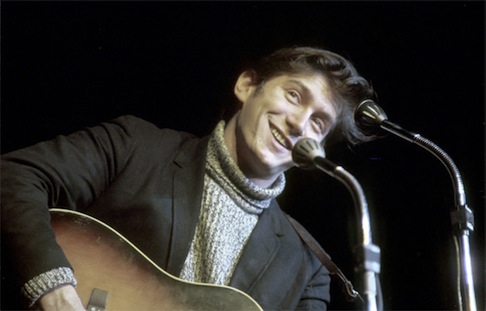Phil Ochs finally graduates to American Masters status
01/27/12 12:00 PM

By ED BARK
My affinity is genuine for the immensely talented and tragically self-destructive Phil Ochs.
But before elaborating, let's note that Dallas-based KERA13's treatment of Phil Ochs: There But For Fortune is pretty much the story of his life.
It aired nationally in most markets on Jan. 23rd as the 26th season opener of PBS' esteemed American Masters series. But the film arrives in D-FW on Saturday, Jan. 28th, shuffled off to KERA World, the 13.2 over-the-air channel that many viewers still aren't getting on their cable or satellite systems. Show times are 8 a.m., 2 p.m. and 9 p.m. Thankfully, the 1 hour, 23 minute film also is newly available online right here.
For some reason I much preferred Ochs to Bob Dylan during their flowering days as folk/protest singers. Ochs' voice indisputably was sweeter and more melodic, and his unflinching anti-war songs had far more topical bite. But as the late Christopher Hitchens notes in There But For Fortune, "Anyone could like Bob Dylan. Everyone did." And Dylan's pre-eminince, throughout Ochs' short life, "was a very big part of Phil's pathology," says Sam Hood, a friend and onetime manager of Greenwich Village's old music mecca, The Gaslight Cafe.
Ochs hung himself on April 9, 1976, checking out at the age of 35. I bought and still have all seven of his studio albums, with the last one, Phil Ochs Greatest Hits, framed and hanging on the walkup wall to my office here at unclebarky.com central. Paradoxically, I bought it in 1970, the last year of my service in the U.S. Marines.
Ochs never had a greatest hit, at least from a chart-topping standpoint. So the album, picturing him in an Elvis-like gold lame suit, was intentionally self-deprecating. Still, many of its songs were first rate. And in the closing minutes of There But For Fortune, Ochs is shown singing the album's "Jim Dean of Indiana," which he would play for hours on end at the piano during the last year of his life.
I last saw Ochs in April 1974 at the Stone Hearth club in Madison, Wisconsin. I was a UW student at the time, writing for The Daily Cardinal. The night's featured attraction was in very bad shape and very, very late to the stage. I first glimpsed him in the men's rest room, banging his head against the wall while taking unsteady aim at a urinal. He was blasted.
He later apologized for his "drunken state" after the club's manager helped to prop him up on a stool. Ochs just didn't like the '70s very much. At one point he blurted, "You can't visit a college campus today without being approached by some spiritual asshole."
It got better, though, as the night went on. Ochs summoned the remains of his ravaged voice, playing and singing with increasing steadiness and power. Pathetic slowly yielded to poignant. Afterward, a small group of us sat at a table with him while he passed the hat for money that supposedly would go toward a Chilean defense fund. It very likely didn't.
There But For Fortune recaptures Ochs in his prime while also documenting his descent into depression and alcoholism. His wife, Alice, brother, Michael and daughter, Meegan, are all newly interviewed. All understandably choose to remember him fondly as a singer/songwriter whose demons did him in.
Near the end, Ochs and Dylan performed together at Carnegie Hall in a 1973 benefit concert titled "An Evening with Salvador Allende" (in honor of both the late overthrown Marxist president of Chile and protest singer Victor Jara, a friend of Ochs who was murdered in the aftermath of the military coup).
To his credit, Dylan signed on belatedly after learning that the concert likely would be canceled without his attendant star power. It then quickly sold out, and There But For Fortune includes several telling still photos of a bloated-looking Ochs performing with his trim,, bewhiskered foe/ally.
Dylan does not, however, contribute an interview for this film. But Joan Baez does, She knew him at his heights and depths. And during Ochs' flickering last months, they performed "There But For Fortune" together at a Central Park concert celebrating the 1975 end of the Vietnam War. Ochs then lost it for good.
"He became as famous as he should have been," says singer Judy Henske. "He never made you feel warm and wonderful" like The Kingston Trio or Peter, Paul and Mary did.
Dylan lives on, ever-productive and the earlier subject of a 2005 American Masters portrait -- No Direction Home -- that ran more than twice as long as There But For Fortune and was directed by Martin Scorsese.
Ochs has now been in his grave longer than he was alive. He has only himself to blame for that. And some of us still take it pretty personally.
GRADE: A
Addendum: Got a few minutes? Here's one of my favorite Phil Ochs songs, among many:
